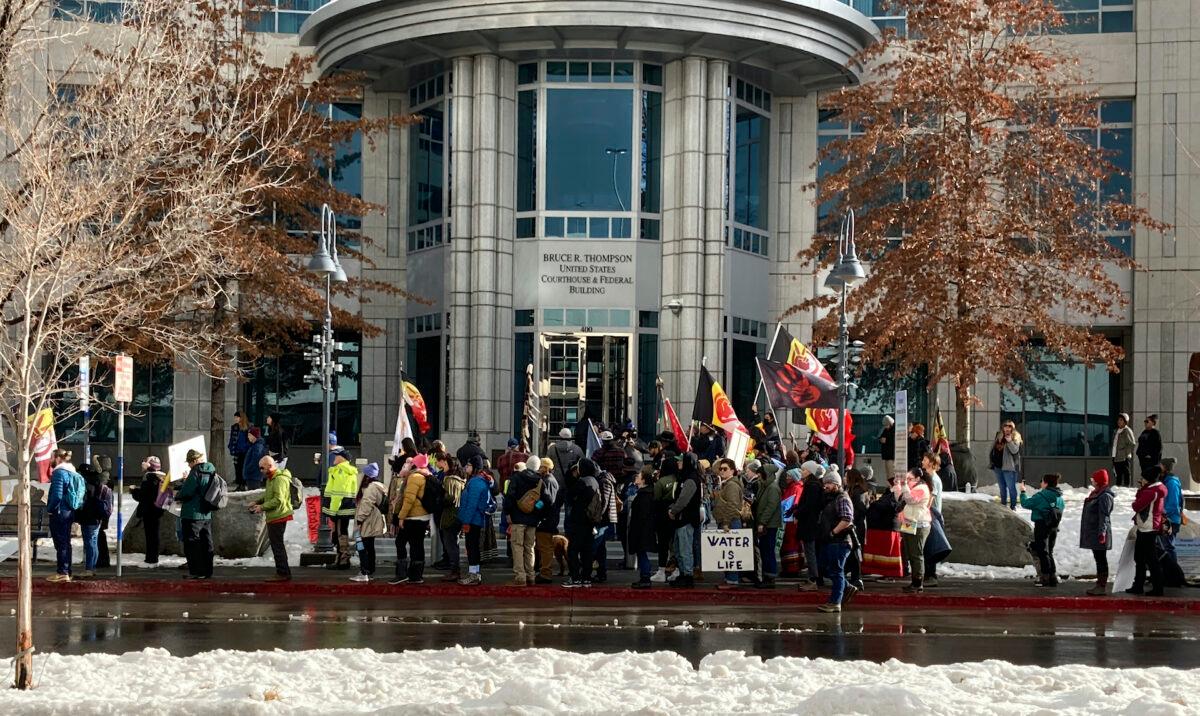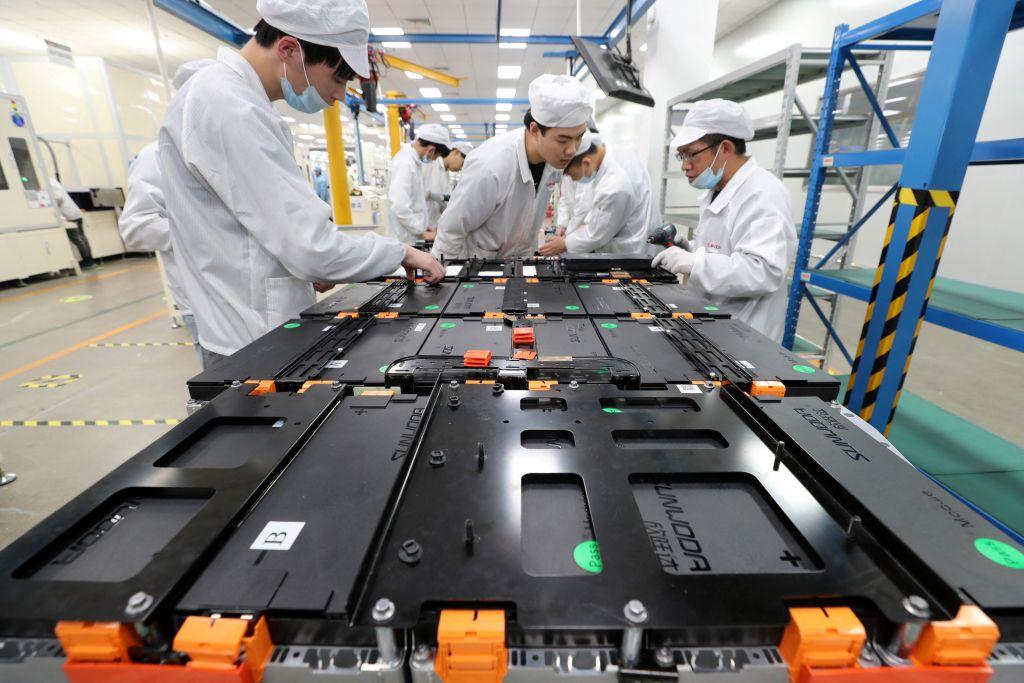Few of 80 planned lithium projects in Nevada will survive litigative, regulatory review. Those that do may need subsidies to offset China ‘cartel’ price fixing.
President Joe Biden is encouraging investors to put their money where his mouth is—and where billions of dollars in federal tax credits and grants are going—to spur a renewable energy push that is being mired in intractable quagmires because of a cumbersome regulatory process and his own contradictory policies, according to critics.
Those clashing zephyrs are colliding across Nevada’s ridge-ribbed brine flats and desert valleys, where the nation’s only lithium mine subsists and more than 80 proposed lithium projects remain suspended in years-long permitting purgatories or are limping into long-delayed preliminary development under tentative, conditional approvals.
Lithium is the “white gold” of “green energy” development. Along with copper, nickel, and cobalt, it is among the critical minerals and metals that power rechargeable batteries for electric vehicles, solar panels, wind turbines, and the circuitry of contemporary life, such as cell phones and laptops.
According to the International Energy Agency, the global lithium market will increase sixfold between 2020 and 2030. Demand is projected to increase another sixfold between 2030 and 2040 and tenfold by 2050. As with copper, nickel, and cobalt, the United States has ample deposits of lithium, more than enough to meet domestic production needs and be a dominant global market force.
The U.S. Geological Survey estimates that there are at least 14 million metric tons of the white-colored metal locked in deposits across the country, including large deposits in North Carolina’s Tin-Spodumene Belt, California’s “Lithium Valley,” and Nevada.
However, the United States produces just 1 percent of the global supply of lithium, and efforts to boost domestic production are routinely ensnared in regulatory roadblocks, yearslong permitting limbos, and exhaustive litigation.
That is why investing in lithium development—or any extractive effort in the United States—is a bad bet, according to Ian Lange, mineral and energy economics program director at the Colorado School of Mines.
Some obstacles, such as permitting and regulatory redundancy, can be remedied through legislation, but that’s not on the congressional horizon despite bipartisan calls for reform, he said.
“Permitting is a thing everybody talks about, but I don’t think anyone has a good answer,” he told The Epoch Times. “That somehow has to be solved, and I would say no party has a good idea.”
In January 2023, the Treasury Department mandated that critical minerals and metals needed to meet the dramatically increasing electricity demands must be domestically sourced.
That’s wishful thinking, according to Mr. Lange, especially when undermined by contradictory Biden-imposed bureaucratic hurdles that threaten to deny or have derailed the same proposed Nevada lithium, Arizona copper, Minnesota nickel, and Idaho cobalt projects being incentivized by the administration.
While 2022’s Infrastructure Reduction Act (IRA) commits billions of dollars to the research and development of hydrogen fuel cells and other green energies, not a dime is earmarked for excavation.
“The IRA just totally ignores mining. Of the loans [the administration] has been handing out, it’s not for the mining but for the processing,” Mr. Lange said. “There’s essentially no mining support in the IRA. There’s only processing support.”
While the Biden administration is pushing renewable energies in a “forced transition” to meet its 2035 carbon-free domestic power and 2050 net-zero emissions goals, its regulatory policies remain stubbornly hostile to extractive industries, he said.
Mr. Lange said that the administration “wants these technologies that need critical minerals, but critical minerals mean you have to move dirt,” and that, in essence, means scraping away the regulatory rust that encases the nation’s moribund mining industry.

Emerging 2024 Campaign Issue
How to do that is a campaign issue, especially across the inter-mountain West. Sens. Catherine Cortez Masto (D-Nevada) and Jacky Rosen (D-Nevada)—who faces a “tossup” reelection challenge in November—both signed a Feb.14 letter calling on President Biden to give a tax credit against the cost of extraction for proposed lithium mines.
In Utah’s gubernatorial race, GOP challenger Carson Jorgensen frequently criticizes incumbent Republican Gov. Spencer Cox for not vocally backing state and congressional lawmakers in lobbying for state control of federal lands to revive mining economies.
”There’s a lot of talk about it, but we’ve not seen a ton of action moving forward,” he told the Epoch Times. “From lithium to uranium to oil to natural gas, all of our energy basically is controlled by the federal government. Yes, we want to provide this to the country, but it’s going to take a large push-back against the federal government, and the leadership we have right now [Mr. Cox] is not willing to do that.”
Utah, Arizona, and Nevada congressional candidates—including some Democrats—intertwine critical minerals development with longstanding friction with federal land management and energy policies with the need to amend mining laws and mend fences with communities despoiled by past mining operations.
Among a gaggle of GOP contenders seeking to unseat Rep. Susie Lee (D-Nevada) in Nevada’s Las Vegas-area Third Congressional District, challenger Drew Johnson said reviving the nation’s mining industry is not merely an economic must, but vital to the nation’s security.
“This is something I’m very aware of and it’s so frustrating to think that we can be a leader in lithium, but instead we have to go get the lithium that we need for our new technologies from China, which, of course, is the nation’s top threat,” he said.

Stillborn Into a Monopolized Market
However, that won’t change without dramatic boosts in federal subsidies to keep unprofitable mines operating, perhaps for years, Mr. Lange said, which would be a very unpopular prospect, especially among fiscal hawks and Republicans already critical of the administration’s renewable energy investments, which they say come at the expense of oil and gas development.
“Understanding the market that you’re in, I would say that’s an important first step,” but one that appears to elude the administration and Congress, he said.
“Not many people are talking about the mines in the U.S. that have tried to open and run into this problem; China is the market’s cartel/monopolist,” Mr. Lange said. “If they don’t want you to open, it’s pretty easy for them to be like, ‘Hey, every potential customer, let’s cut the cost of the [mineral/metal] this new mine might be trying to sell you.’”
And with that, “those projects die,” stillborn even after years of regulatory and litigative struggles, like Australia-based Jervois Global’s Idaho cobalt mine, which was set to open in March but remains closed because of a price crash.
“Why was the cobalt price too low? The Chinese were producing a ton of it to crash the price,” he said.
“Why would anybody sign a contract [with the new mine] when they can get a really good price [from Chinese producers]?” Mr Lange asked.
That certainty awaits U.S. attempts to produce domestic lithium, including the 80 proposed projects in Nevada, he said. Whereas a metric ton of lithium carbonate topped $84,000 in November 2022, on April 29, it was trading at $13,540 a metric ton.
Yet there’s no plan or policy to subsidize or assist mining operations in gaining the productive momentum to compete.
“I think that’s probably where the conversation should go,” Mr. Lange said. “You’re going against a monopolist cartel, so it is not like if they got some capital they‘d be fine, or if we built a better mousetrap, dig a little deeper, we’d be fine, right? China can just crash the price when they want.”
Original News Source Link – Epoch Times
Running For Office? Conservative Campaign Consulting – Election Day Strategies!


